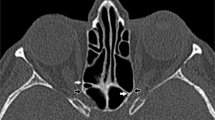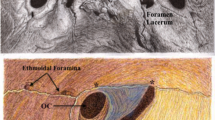Abstract
Background
The medial opticocarotid recess (MOCR) is located in the posterior wall of the sphenoid sinus, medial to the junction of the optic canal (OC) and the carotid prominence (CP). There is controversy in the literature in relation to the presence of the MOCR and its constancy, which is relevant when approaching the skull base through an endoscopic route.
Methods
The morphometric relations of the MOCR with the surrounding structures were studied in 18 cadaveric specimens after endoscopic endonasal approach (EEA).
Results
The distance between both MOCR was 11.06 ± 1.14 mm; the distance between the MOCR and the lateral opticocarotid (LOCR) recess was 5.56 ± 0.85 mm; the distance between the MOCR and the suprasellar recess was 3.72 ± 0.49 mm; the angle between the MOCR plane and the OC 13.32 ± 2.30°; the angle between the MOCR plane and the CP 13.50 ± 2.68° and; the angle between the OC and the CP 26.81 ± 4.26°. All measurements showed low variability, with low standard deviation and interquartile range. No relations were found between any of the measurements.
Conclusions
The MOCR may be used as a reference point for precise location of structures during EEA. Objective measurements may be especially useful in cases with distorted sphenoid bone anatomy.






Similar content being viewed by others
References
Ahuja A, Guterman LR, Hopkins LN (1992) Carotid cavernous fistula and false aneurysm of the cavernous carotid artery: complications of transsphenoidal surgery. Neurosurgery 31(4):774–778
Fernandez-Miranda JC, Gardner PA, Prevedello DM, Kassam AB (2009) Expanded endonasal approach for olfactory groove meningioma. Acta Neurochir 151(3):287–288
Gardner PA, Tormenti MJ, Pant H, Fernandez-Miranda JC, Snyderman CH, Horowitz MB (2013) Carotid artery injury during endoscopic endonasal skull base surgery: incidence and outcomes. Neurosurgery 73(2 Suppl Operative):261–269
Hamberger CA, Hammer G, Norlen G, Sjogren B (1961) Transantrosphenoidal hypophysectomy. Arch Otolaryngol 74:22–28
Hamid O, El Fiky L, Hassan O, Kotb A, El Fiky S (2008) Anatomic variations of the sphenoid sinus and their impact on trans-sphenoid pituitary surgery. Skull Base 18(1):9–15
Hyde-Rowan MD, Roessmann U, Brodkey JS (1983) Vasospasm following transsphenoidal tumor removal associated with the arterial changes of oral contraception. Surg Neurol 20(2):120–124
Jho HD (1999) Endoscopic pituitary surgery. Pituitary 2(2):139–154
Kassam AB, Snyderman CH, Mintz A, Gardner P, Carrau RL (2005) Expanded endonasal approach: the rostrocaudal axis. Part I. Crista galli to the Sella turcica. Neurosurg Focus 19(1):E3
Kassam AB, Gardner PA, Snyderman CH, Carrau RL, Mintz AH, Prevedello DM (2008) Expanded endonasal approach, a fully endoscopic transnasal approach for the resection of midline suprasellar craniopharyngiomas: a new classification based on the infundibulum. J Neurosurg 108(4):715–728
Labib MA, Prevedello DM, Fernandez-Miranda JC, Sivakanthan S, Benet A, Morera V, Carrau R, Kassam A (2013) The medial opticocarotid recess: an anatomic study of an endoscopic “key landmark” for the ventral cranial base. Neurosurgery 72(1 Suppl Operative):66–76
Laws EW (1991) Complications of transsphenoidal surgery. In: Samii M (ed) Surgery of the sellar region and paranasal sinuses. Springer, Berlin Heidelberg, pp 336–340
Lee KJ (1978) The sublabial transseptal transsphenoidal approach to the hypophysis. Laryngoscope 88(7 Pt 2 Suppl 10):1–65
Ozcan T, Yilmazlar S, Aker S, Korfali E (2010) Surgical limits in transnasal approach to opticocarotid region and planum sphenoidale: an anatomic cadaveric study. World Neurosurg 73(4):326–33
Paluzzi A, Fernandez-Miranda JC, Tonya Stefko S, Challinor S, Snyderman CH, Gardner PA (2014) Endoscopic endonasal approach for pituitary adenomas: a series of 555 patients. Pituitary 17(4):307–19
Peris-Celda M, Kucukyuruk B, Monroy-Sosa A, Funaki T, Valentine R, Rhoton AL (2013) The recesses of the sellar wall of the sphenoid sinus and their intracranial relationships. Neurosurgery 73(2 Suppl Operative):117–31
Romano A, Zuccarello M, van Loveren HR, Keller JT (2001) Expanding the boundaries of the transsphenoidal approach: a microanatomic study. Clin Anat 14(1):1–9
Zada G, Agarwalla PK, Mukundan S Jr, Dunn I, Golby AJ, Laws ER Jr (2011) The neurosurgical anatomy of the sphenoid sinus and sellar floor in endoscopic transsphenoidal surgery. J Neurosurg 114(5):1319–30
Author information
Authors and Affiliations
Corresponding author
Ethics declarations
Funding
No funding was received for this research.
Conflict of interest
The author(s) declare that they have no competing interests.
Ethical approval
All procedures performed in studies involving human participants were in accordance with the ethical standards of the institutional and/or national research committee and with the 1964 Helsinki Declaration and its later amendments or comparable ethical standards.
Formal consent
For this type of study formal consent is not required.
Rights and permissions
About this article
Cite this article
Nunes, C.F., Prevedello, D.MS., Carrau, R.L. et al. Morphometric analysis of the medial opticocarotid recess and its anatomical relations relevant to the transsphenoidal endoscopic endonasal approaches. Acta Neurochir 158, 319–324 (2016). https://doi.org/10.1007/s00701-015-2662-7
Received:
Accepted:
Published:
Issue Date:
DOI: https://doi.org/10.1007/s00701-015-2662-7




